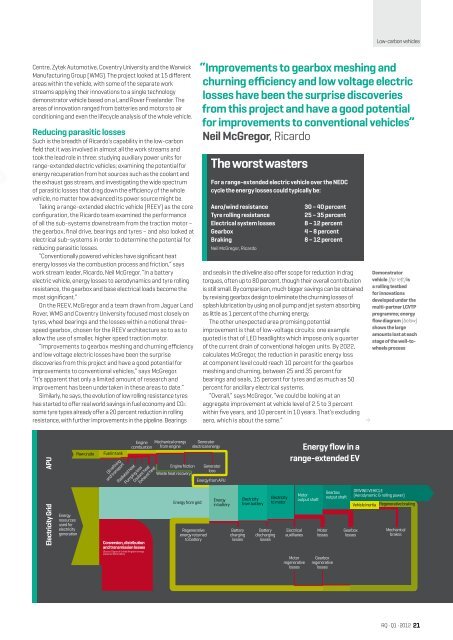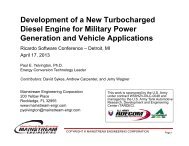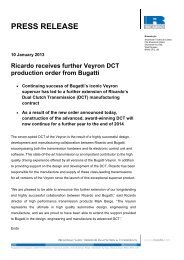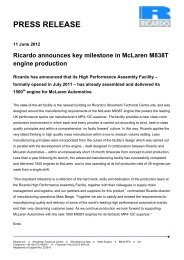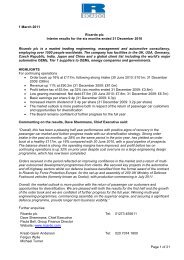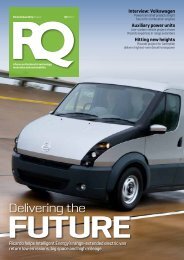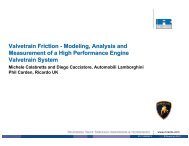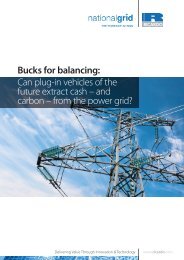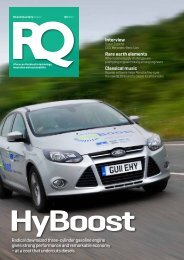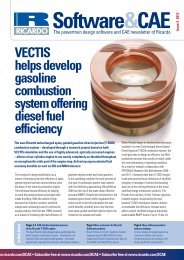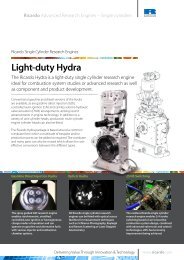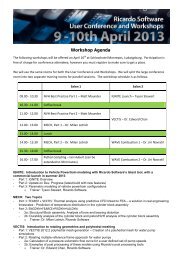Peak - Ricardo
Peak - Ricardo
Peak - Ricardo
Create successful ePaper yourself
Turn your PDF publications into a flip-book with our unique Google optimized e-Paper software.
Low-carbon vehicles<br />
Centre, Zytek Automotive, Coventry University and the Warwick<br />
Manufacturing Group (WMG). The project looked at 15 different<br />
areas within the vehicle, with some of the separate work<br />
streams applying their innovations to a single technology<br />
demonstrator vehicle based on a Land Rover Freelander. The<br />
areas of innovation ranged from batteries and motors to air<br />
conditioning and even the lifecycle analysis of the whole vehicle.<br />
Reducing parasitic losses<br />
Such is the breadth of <strong>Ricardo</strong>’s capability in the low-carbon<br />
field that it was involved in almost all the work streams and<br />
took the lead role in three: studying auxiliary power units for<br />
range-extended electric vehicles; examining the potential for<br />
energy recuperation from hot sources such as the coolant and<br />
the exhaust gas stream, and investigating the wide spectrum<br />
of parasitic losses that drag down the efficiency of the whole<br />
vehicle, no matter how advanced its power source might be.<br />
Taking a range-extended electric vehicle (REEV) as the core<br />
configuration, the <strong>Ricardo</strong> team examined the performance<br />
of all the sub-systems downstream from the traction motor –<br />
the gearbox, final drive, bearings and tyres – and also looked at<br />
electrical sub-systems in order to determine the potential for<br />
reducing parasitic losses.<br />
“Conventionally powered vehicles have significant heat<br />
energy losses via the combustion process and friction,” says<br />
work stream leader, <strong>Ricardo</strong>, Neil McGregor. “In a battery<br />
electric vehicle, energy losses to aerodynamics and tyre rolling<br />
resistance, the gearbox and base electrical loads become the<br />
most significant.”<br />
On the REEV, McGregor and a team drawn from Jaguar Land<br />
Rover, WMG and Coventry University focused most closely on<br />
tyres, wheel bearings and the losses within a notional threespeed<br />
gearbox, chosen for the REEV architecture so to as to<br />
allow the use of smaller, higher speed traction motor.<br />
“Improvements to gearbox meshing and churning efficiency<br />
and low voltage electric losses have been the surprise<br />
discoveries from this project and have a good potential for<br />
improvements to conventional vehicles,” says McGregor.<br />
“It’s apparent that only a limited amount of research and<br />
improvement has been undertaken in these areas to date.”<br />
Similarly, he says, the evolution of low rolling resistance tyres<br />
has started to offer real world savings in fuel economy and CO2:<br />
some tyre types already offer a 20 percent reduction in rolling<br />
resistance, with further improvements in the pipeline. Bearings<br />
“Improvements to gearbox meshing and<br />
churning efficiency and low voltage electric<br />
losses have been the surprise discoveries<br />
from this project and have a good potential<br />
for improvements to conventional vehicles”<br />
Neil McGregor, <strong>Ricardo</strong><br />
The worst wasters<br />
For a range-extended electric vehicle over the NEDC<br />
cycle the energy losses could typically be:<br />
Aero/wind resistance<br />
Tyre rolling resistance<br />
Electrical system losses<br />
Gearbox<br />
Braking<br />
Neil McGregor, <strong>Ricardo</strong><br />
30 – 40 percent<br />
25 – 35 percent<br />
8 – 12 percent<br />
4 – 8 percent<br />
8 – 12 percent<br />
and seals in the driveline also offer scope for reduction in drag<br />
torques, often up to 80 percent, though their overall contribution<br />
is still small. By comparison, much bigger savings can be obtained<br />
by revising gearbox design to eliminate the churning losses of<br />
splash lubrication by using an oil pump and jet system absorbing<br />
as little as 1 percent of the churning energy.<br />
The other unexpected area promising potential<br />
improvement is that of low-voltage circuits: one example<br />
quoted is that of LED headlights which impose only a quarter<br />
of the current drain of conventional halogen units. By 2022,<br />
calculates McGregor, the reduction in parasitic energy loss<br />
at component level could reach 10 percent for the gearbox<br />
meshing and churning, between 25 and 35 percent for<br />
bearings and seals, 15 percent for tyres and as much as 50<br />
percent for ancillary electrical systems.<br />
“Overall,” says McGregor, “we could be looking at an<br />
aggregate improvement at vehicle level of 2.5 to 3 percent<br />
within five years, and 10 percent in 10 years. That’s excluding<br />
aero, which is about the same.”<br />
Demonstrator<br />
vehicle (far left) is<br />
a rolling testbed<br />
for innovations<br />
developed under the<br />
multi-partner LCVTP<br />
programme; energy<br />
flow diagram (below)<br />
shows the large<br />
amounts lost at each<br />
stage of the well-towheels<br />
process<br />
Electricity Grid APU<br />
Energy<br />
resources<br />
used for<br />
electricity<br />
generation<br />
Raw crude<br />
Fuel in tank<br />
Oil refining<br />
and transport<br />
Conversion, distribution<br />
and transmission losses<br />
(Source Digest of United Kingdom energy<br />
statistics DECC 2010)<br />
Engine Mechanical energy<br />
combustion from engine<br />
Radiated heat<br />
Pumping loss<br />
Coolant heat<br />
Exhaust heat<br />
Energy from grid<br />
Generator<br />
electrical energy<br />
Engine friction Generator<br />
Waste heat recovery<br />
loss<br />
Energy from APU<br />
Regenerative<br />
energy returned<br />
to battery<br />
Energy<br />
in battery<br />
Battery<br />
charging<br />
losses<br />
Electricity<br />
from battery<br />
Battery<br />
discharging<br />
losses<br />
Electricity<br />
to motor<br />
Energy flow in a<br />
range-extended EV<br />
Electrical<br />
auxilliaries<br />
Motor<br />
regenerative<br />
losses<br />
Motor<br />
output shaft<br />
Motor<br />
losses<br />
Gearbox<br />
regenerative<br />
losses<br />
Gearbox<br />
output shaft<br />
Gearbox<br />
losses<br />
DRIVING VEHICLE<br />
(Aerodynamic & rolling power)<br />
Vehicle inertia Regenerative braking<br />
Mechanical<br />
brakes<br />
RQ • Q1 • 2012 21


